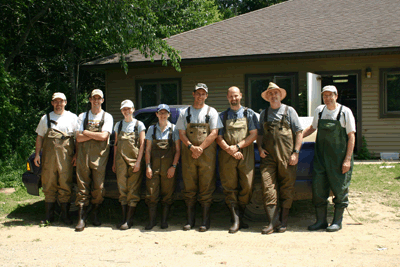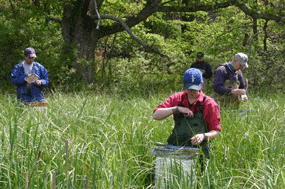 Amphibian Metacommunities
Amphibian Metacommunities
PIs: Earl Werner (UM), Rick Relyea (Pitt), Dave Skelly (Yale) and Mike Benard (Case Western).
Summary
This research project is focused around a long-term survey of the communities composed of 14 species of amphibians and over 150 taxa of macroinvertebrates (including all amphibian predators) in 37 ponds on the E. S. George Reserve. The survey in part is motivated by the critical need for long term data on multiple interacting species across multiple sites to provide inferences on the interplay of local and regional processes structuring metacommunities. We have quantitative data on species’ densities in these ponds in each year since 1996. In particular, we are interested in the long-term dynamics of amphibian communities; initial studies based on survey results have examined the biotic and abiotic factors associated with patterns in amphibian species richness on environmental gradients, the interannual turnover in species composition of amphibian metacommunities and factors responsible for this turnover, and the effects of landscape dynamics (due to climatic drivers) on the population dynamics and spatial ecology of amphibians. We also have examined similar patterns in several macroinvertebrate metacommunities (e.g., > 40 species of larval dragonflies and 24 species of snails) of these ponds. A goal of this project is to use “scale transition theory” to test hypotheses concerning the spatial mechanisms contributing to spatial dynamics as we scale up from local (pond) population dynamics to large-scale patterns in species abundances andimages: survey2.gif pond occupancy rates.  A large number of “spin-off” projects have been initiated based on patterns from this survey work, including studies on: 1) the causes and scope of phenotypic plasticity in larval anurans and 2) its role in species interactions (e.g. trait-mediated indirect effects), 3) growth/mortality tradeoffs and the role of this tradeoff in species distributions, 4) genetic differentiation, local adaptation and population dynamic modeling of wood frog populations, 5) the effects of pond environments on stress hormones levels in anuran larvae and the long term fitness consequences, and 6) patterns in parasite infection rates and their consequences to amphibian larvae.
A large number of “spin-off” projects have been initiated based on patterns from this survey work, including studies on: 1) the causes and scope of phenotypic plasticity in larval anurans and 2) its role in species interactions (e.g. trait-mediated indirect effects), 3) growth/mortality tradeoffs and the role of this tradeoff in species distributions, 4) genetic differentiation, local adaptation and population dynamic modeling of wood frog populations, 5) the effects of pond environments on stress hormones levels in anuran larvae and the long term fitness consequences, and 6) patterns in parasite infection rates and their consequences to amphibian larvae.
Relevant Links:
Relyea Lab website
Skelly Lab website
Benard Lab website
Return to Research Projects list
